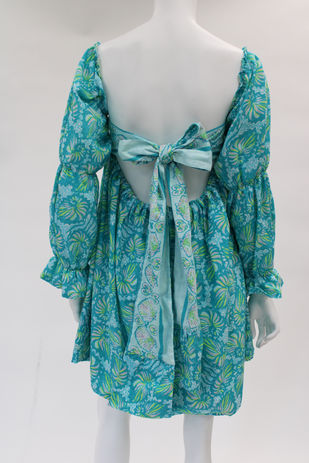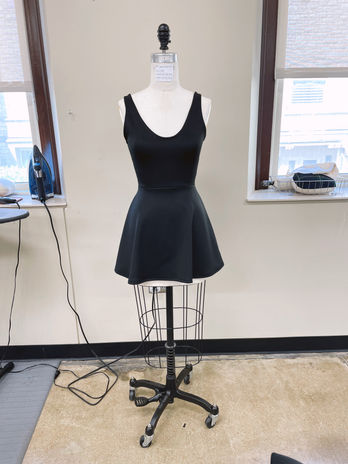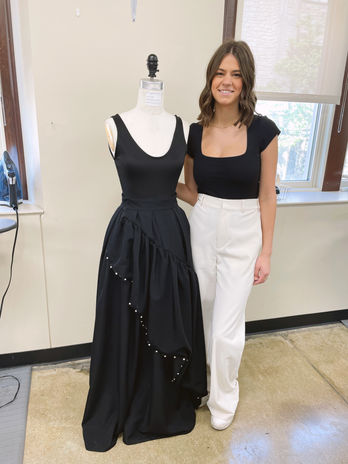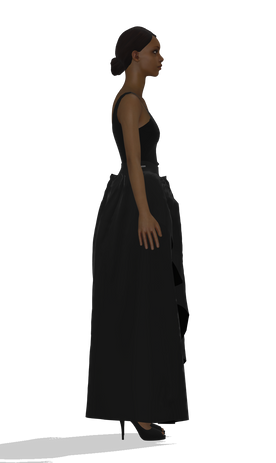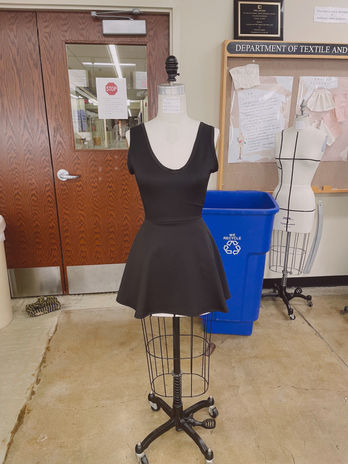Take it to the Coast:
Zero Waste Design
Zero waste design is an approach to sustainable fashion. For this project, I was assigned a random piece of fabric and prompted to create an ensemble using the entire piece. What I did not use had to fit in a sandwich-size ziplock bag (as shown in my gallery of pictures). I used draping techniques to design my dress. My biggest challenge was using all of my fabric, but I ended up using my scraps for a skirt facing. How I used all of my fabric can be seen in the fabric marker on my presentation board. I learned a lot about zero waste & sustainability and their importance with this project.
Game, Set, Dance! A Ginger Rogers-Inspired Design
Statement of Purpose
Ginger Rogers was a Hollywood Star from Independence, MO who acted and performed from the 1920s to the 1990s. She was in a total of seventy-three films and is responsible for taking Hollywood musical films to another level with her co-star Fred Astaire (Ginger Rogers, 2020). Not only did she make an impact on performance and film, but she also is an iconic symbol of fashion. She helped define the style of the 1930s and continues to shape fashion today (Truhler, 2014). Roger’s influence on fashion was even brought to the homes of average Americans with the creation of Ginger Rogers Hollywood Sewing Patterns (Johnston, 2023). One of Rogers’ avid hobbies was tennis. She regularly participated in tournaments and even played in the 1950s U.S. Open Championships in the mixed doubles category with Frank Shields (Perry, 2019).
Ginger Rogers’s strides on and off the stage, specifically the tennis courts, serve as the main piece of inspiration for Game, Set, Dance. The task was to create an ensemble inspired by Ginger Rogers. “Game, Set, Dance” provides two different looks for the Hollywood Star. The first is a knit tennis dress Rogers could have worn while playing, and the second is a wrap-overskirt to wear on top of the dress for entertaining. The look is elegant yet playful to enhance the movements Roger would have performed on stage. The ensemble is an adaptation and interpretation of performance wear from the 1930s and a vision of what Ginger Rogers would wear today.
Aesthetics and Visual Impact
Game, Set, Dance represents an elegant and timeless approach to a transformational ensemble. Keeping in mind it needed to provide two different looks, balance and emphasis were two important elements to consider. The all-black color palette represents the balance throughout the ensemble. The color also makes it transition seamlessly from daytime with the tennis dress to evening once the overskirt is added. The box pleats and ruffle on the skirt add emphasis to the overall appearance and aesthetics of the garment. Furthermore, the beading on the edge of the ruffle also adds emphasis to draw the eye along the edge of the skirt, and the white pearls add contrast against the black fabric.
Process, Technique, and Execution
The design process for Game, Set, Dance began with sketching. Ginger Rogers’s participation in tennis served as immediate inspiration, so it was clear that designing a look to serve two purposes was the end goal of the ensemble. Around twenty different sketches were generated before a final concept was chosen: a v-neck with a scoop back and a flare-skirt tennis dress with an asymmetrical wrap-over skirt. After selecting a design, draping a sample was the next step. I began with the tennis dress and learned how to drape with knit fabric, which entails no shaping devices. When draping the skirt, I needed to learn how to do box pleats. YouTube taught me how to do them by manipulating fabric in either direction to create a fold (YouTube, 2018). Once the drape sample was done, the next step was to transfer the fabric into paper patterns. During this process, I perfected the pieces from the sample so a fitting muslin could be made. The biggest challenge I faced with the fitting muslin was sewing knit fabric for the first time. YouTube and my draping instructor (Professor Smith) served as a great resource for learning techniques for this material. The binding for the armholes and neckline was the biggest learning curve. The binding was bulky for the fitting muslin, but with the use of the overlock machine and folding over the binding another time, I was able to fix the problem for my final garment. The execution of Game, Set, Dance ended with a fully-lined wrap skirt with hand-sewn beading and a gathered asymmetric ruffle completed with a full-flare tennis dress.


